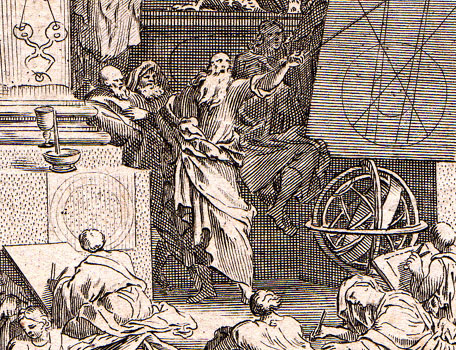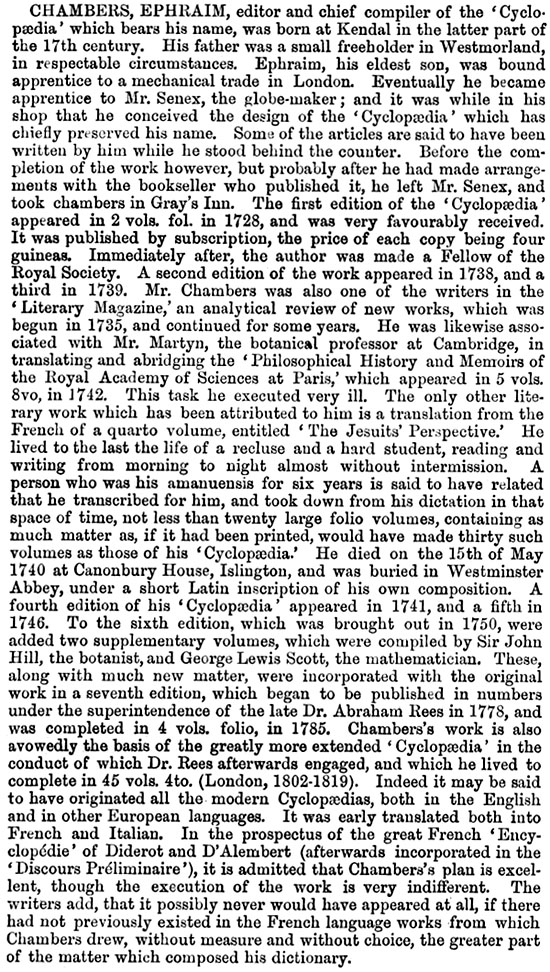
Ephraim Chambers (c.1680-1740)
Apprenticed to a London cartographer, 'was seized by the idea that Harris's Lexicon needed bringing up to date and that he was the man to do this work so seemingly disproportionate to any single person's experience'. A good French scholar, he adapted Moreri and Bayle to the common-sense climate of the English Enlightenment. Moreover, he introduced a novel device that has proved indispensable to every subsequent lexicographer and encyclopaedist, namely, cross-references; so that "a chain may be carried on from one end of an art to the other" (PMM).
Regarding this fundamentally important work, Walsh has written: 'Although the Cyclopaedia is now but a landmark in the history of encylopedia publishing, its impact and influence upon later generations was incalculable. It directly influenced the famous French Encyclopedie of Diderot, and the New Cylopaedia compiled by Abraham Rees and published between 1802 and 1820 ... Less directly, the pioneering example of the Cyclopaedia stimulated the publication of the Encylopaedia Britannica and many subsequent works' (Anglo-American General Encylopedias, quoted in Alston).
Alston III, 535; O'Neill C-26; PMM 171
"Ephraim Chambers was born in the Lake District about 1680 and was trained as a map-maker. Inspired by the example of John Harris's Lexicon technicum, he set out to compile a more comprehensive work. Though to Harris must go the honours of compiling the first true English encyclopedia, Chambers is clearly the father of the modern encyclopedia throughout the world. Chamber's Cyclopaedia is particularly remarkable for its elaborate system of cross-references, and for the broadening of Harris's coverage to include more of the humanities. The influence of Chamber's encyclopedia has been incalculable: Diderot's Encyclopedie would undoubtedly have taken a very different shape had it not been for Chambers's example. Abraham Ree's own encyclopedia was modeled on Chambers's. The publication of the Encyclopedia Britannica was stimulated by the appearance of the Encyclopedie. and almost every subsequent move in the world of encyclopedia-making is thus directly traceable to the pioneer example of Chambers's work" (Collison, pp. 103-04)
Encyclopaedia Britannica (11th edition)
Vol. 9 p.374
ENCYCLOPAEDIA
Ephraim Chambers (q.v.) published his Cyclopaedia; or an Universal Dictionary of Art and Sciences, containing an Explication of the Terms and an Account of the Things Signified thereby in the several Arts, Liberal and Mechanical, and the several Sciences, Human and Divine, London, 1728, fol. 2 vols.
The dedication to the king is dated October 15, 1727. Chambers endeavoured to connect the scattered articles relating to each subject by a system of references, and to consider the "several matters, not only in themselves, but relatively, or as they respect each other; both to treat them as so many wholes and as so many parts of some greater whole". Under each article he refers to the subject to which it belongs, and also to its subordinate parts; thus Copyhold has a reference to Tenure, of which it is a particular kind, and other references to Rolls, Custom, Manor, Fine, Charterland and Freehold. In his preface he gives an "analysis of the divisions of knowledge", 47 in number, with classed lists of the articles belonging to each, intended to serve as table of contents and also as a rubric or directory indicating the order in which the articles should be read. But it does so very imperfectly, as the lists are curtailed by many et cacteras; thus 19 occur in a list of 119 articles under Anatomy, which has nearly 2200 articles in Reess index. He omits etymologies unless "they appeared of some significance" ; he gives only one grammatical form of each word, unless peculiar ideas are arbitrarily attached to different forms, as precipitate, precipitant, precipitation, when each has an article; and he omits complex ideas generally known, and thus gets free of "a vast load of plebeian words". His work, he says, is a collection, not the produce of one mans wit, for that would go but a little way, but of the whole commonwealth of learning. "Nobody that fell in my way has been spared, antient or modern, foreign nor domestic, Christian or Jew nor heathen". To the subjects given by Harris he adds theology, metaphysics, ethics, politics, logic, grammar, rhetoric and poetry, but excludes history, biography, genealogy, geography and chronology, except their technical parts.
A second edition appeared in 1738, fol. 2 vols., 2466 pages, "retouched and amended in a thousand places". A few articles are added and some others enlarged, but he was prevented from doing more because "the booksellers were alarmed with a bill in parliament containing a clause to oblige the publishers of all improved editions of books to print their improvements separately." The bill after passing the Commons was unex pectedly thrown out by the Lords; but fearing that it might be revived, the booksellers thought it best to retreat though more than twenty sheets had been printed.
Five other editions were published in London, 1739 to 1751-1752, besides one in Dublin, 1742, all in 2 vols. fol. An Italian translation, Venezia, 1748-1749, 4to, 9 vols., was the first complete Italian encyclopaedia. When Chambers was in France in 1739 he rejected very favorable proposals to publish an edition there dedicated to Louis XV. His work was judiciously, honestly and carefully done, and long maintained its popularity. But it had many defects and omissions, as he was well aware; and at his death, on the 15th of May 1740, he had collected and arranged materials for seven new volumes. John Lewis Scott was employed by the booksellers to select such articles as were fit for the press and to supply others. He is said to have done this very efficiently until appointed sub-preceptor to the prince of Wales and Prince Edward. His task was entrusted to Dr (afterwards called Sir John) Hill, who performed it very hastily, and with characteristic carelessness and self-sufficiency, copying freely from his own writings. The Supplement was published in London, 1753, fol. 2 vols., 3307 pages and 12 plates. As Hill was a botanist, the botanical part, which had been very defective in the Cyclopaedia, was the best.
Abraham Rees (1743 - 1825), a famous Nonconformist minister, published a revised and enlarged edition, "with the supplement and modern improvements incorporated in one alphabet", London, 1778-1788, fol. 2 vols., 5010 pages (but not paginated), 159 plates. It was published in 418 numbers at 6d. each. Rees says that he has added more than 4400 new articles. At the end he gives an index of articles, classed under 100 heads, numbering about 57,000 and filling 80 pages. The heads, with 39 cross references, are arranged alphabetically. Subsequently there were reprints.
The Journal of Religion
Volume 70, Number 3, July 1990
Circumscribing Knowledge:
Encyclopedias in Historical Perspective
Lawrence E. Sullivan/Harvard University
Ephraim Chamber's Cyclopaedia: or, An Universal Dictionary of Arts and Sciences (1727; 2d ed., London, 1738, with two-volume supplement in 1753) became the foundation for Diderot's EncyclopÈdie and the Encyclopaedia Britannica. It earned its editor a place in the Royal Society of London and a grave in Westminster Abbey in 1745. Chambers worked as an apprentice for John Senex, a bookseller and globemaker, and he supplemented his income by writing literary essays and translating. Chambers bequeathed to the encyclopedic tradition the technical apparatus of an elaborate system of cross-references. In the entry on "Reference," he argued that multiple cross-references were essential to the constitution of encyclopedic knowledge for, by connecting all the parts of the work, they transformed a compilation into a single treatise. In his preface to the work, Chambers outlined in detail the genealogical tree of knowledge. All knowledge stemmed from two root categories: natural and scientific knowledge formed one root; artificial and technical knowledge constituted the other. These two radical sources then exfoliated into some forty-seven definable branches of knowledge, each one representing a budding discipline. Each discipline could then be described in an ordered way by listing the logical sequence of subtopics it handled. Chambers emphasized science, technology, and philosophy. One irresistible note: there was no place for history to appear in his tree graph of knowledge.
Chambers provided broad coverage of religious topics. In his entry on "Religion" he exhorted tolerance and held up the people of Siam as exemplary in this respect since they encouraged diversity of religious perspectives. In "Fanatick," "Inquisition," and the many articles on heretical sects, he chafed against formal religious institutions (whether Protestant or Catholic) that constrained freedom of thought. Among those who particularly disturbed Chambers were Jesuits, Quietists, Quakers, Papists, and Carmelites. The cross-referencing of these and many other articles reflected Chambers's goal of creating an organization--an inner structure beneath the surface of the text--that made evident the fact that knowledge is a unified, coherent whole and that, consequently, discussion of the known world could be related in one continuous discourse. Although Chambers provided only a brief definition of mythology, he offered an elaborate and insightful analysis of fable in two separate entries. He attributed the origin of poetry to allegoric fables, which were the most ancient means of teaching theological truths. Chambers seemed to anticipate Vladimir Propp's concern for the morphological structure of a tale. In a strategy that parallels the conceptual schematization that underlies his own encyclopedia, Chambers advised readers to look beneath the surface of the fable's story to discern the truth that lies in the fundamental structure of the plot itself. Chambers took a quite different tack from Bayle. For Chambers, "the fable must always imply or convey some truth . . . the fable must instruct. Its essence is to be a symbol, and of consequence to signify somewhat more than is expressed by the letter. ... A series of fictions conceived and composed in this view, would form a treatise of morality preferable to any more direct and methodical treatise."
The communication of science by popular books 1700-1760
Michael Honeybone
The Open University
.......more respectable were the numerous science books published by subscription, again often in large numbers. As a result of the work of Ruth and Peter Wallis, we know that 95 scientific texts were published in this way between 1673 and 1750. Some were very popular. Henry Pemberton's View of Sir Isaac Newton's (1728) had 2,179 subscribers, 2% of whom were women. Thomas Rutherforth's Newtonian book System of Natural (1748) had 1,053 subscribers and in the same year Colin Maclaurin's Account of Sir Isaac Newton Philosophical Discoveries listed 1,227 subscribers who ordered 1,436 copies. Another very successful text re-published by subscription was Ephraim Chambers' Cyclopedia or Universal Dictionary of Arts and Sciences (London 1728) and Dublin(1740), to which 510 people subscribed.
English Cyclopaedia edited by Charles Knight 1866 Biography Vol.II p.155


| Go to Chambers Notes - Page 2 | see more publications by Ephraim Chambers |